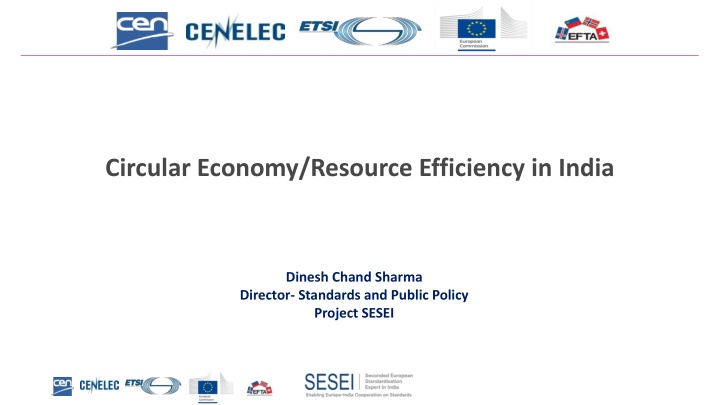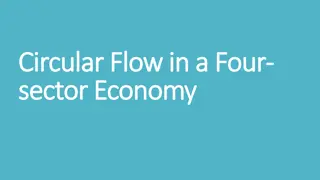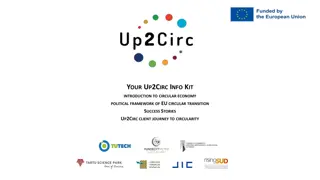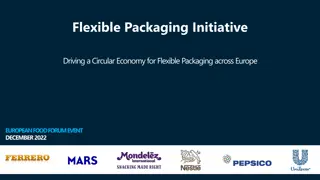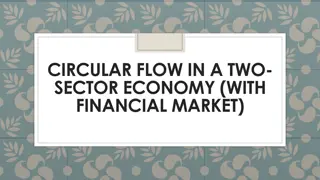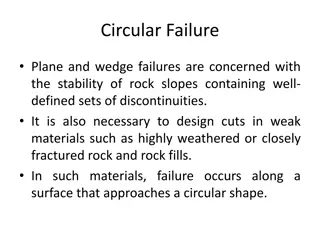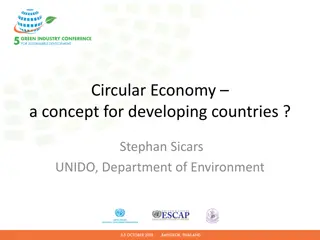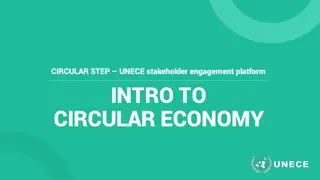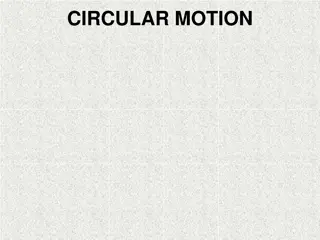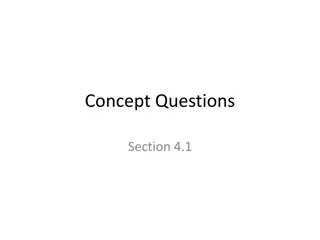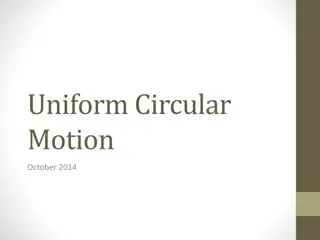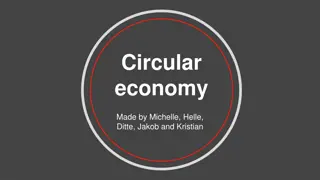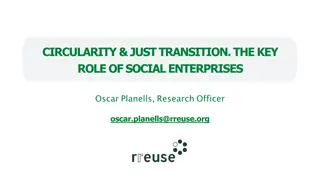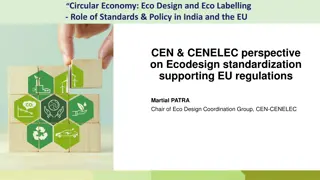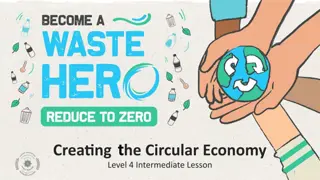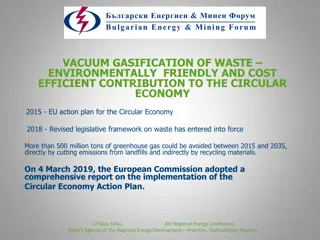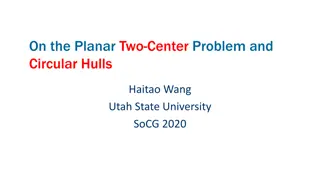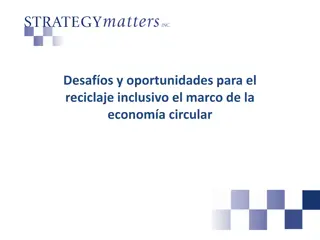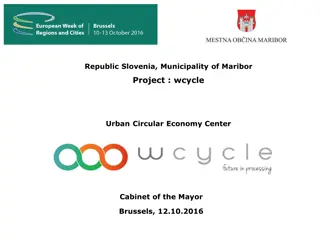Circular Economy and Resource Efficiency Policies in India
India has implemented regulations and policies to manage plastic and e-waste efficiently. The Plastic Waste Management Rules, 2016 aim to increase plastic bag thickness, promote waste recycling, and enforce producer responsibility. The E-Waste Management Rules, 2016 focus on e-waste collection targets and responsibilities for manufacturers and producers. Recent amendments further enhance e-waste management regulations, including stricter compliance testing by the Central Pollution Control Board.
Download Presentation

Please find below an Image/Link to download the presentation.
The content on the website is provided AS IS for your information and personal use only. It may not be sold, licensed, or shared on other websites without obtaining consent from the author.If you encounter any issues during the download, it is possible that the publisher has removed the file from their server.
You are allowed to download the files provided on this website for personal or commercial use, subject to the condition that they are used lawfully. All files are the property of their respective owners.
The content on the website is provided AS IS for your information and personal use only. It may not be sold, licensed, or shared on other websites without obtaining consent from the author.
E N D
Presentation Transcript
Circular Economy/Resource Efficiency in India Dinesh Chand Sharma Director- Standards and Public Policy Project SESEI
Plastic Waste Management Rules Government notified Plastic Waste Management Rules, 2016, in suppression of the earlier Plastic Waste (Management and Handling) Rules, 2011. Plastic Waste Management Rules, 2016 aim to: Increase minimum thickness of plastic carry bags and plastic sheets from 40 to 50 micron To bring in the responsibilities of producers and generators, both in plastic waste management system and to introduce collect back system of plastic waste by the producers/brand owners, as per extended producers' responsibility; Rules direct that a plastic waste management fee be collected through pre-registration of the producers, importers of plastic carry bags/multilayered packaging and vendors selling the same for establishing the waste management system; To promote use of plastic waste for road construction as per Indian Road Congress guidelines or energy recovery, or waste to oil etc. for gainful utilization of waste and also address the waste disposal issue; to entrust more responsibility on waste generators, namely payment of user charge as prescribed by local authority, collection and handing over of waste by the institutional generator, event organizers. Ministry of Environment, Forests and Climate Change (MoEFCC) has notified Plastic Waste Management Amendment Rules, 2021, which prohibits identified single use plastic items which have low utility and high littering potential by 2022. Download Plastic Waste Management (Amendment) Rules, 2021>>
E-Waste Management Rules E-Waste (Management) Rules, 2016 replaced E-Waste (Management and Handling) Rules, 2011 Regulation applies to every manufacturer, producer, consumer, bulk consumer, collection centres, dealers, e-retailer, refurbisher, dismantler and recycler involved in manufacture, sale, transfer, purchase, collection, storage and processing of e-waste or electrical and electronic equipment Responsibilities of manufacturer: Collect waste during manufacturing and recycle or dispose and seek authorization Responsibilities of producers: Collection and channelization EPR- authorization Deposit refund scheme Individual/collective producer responsibility including pretreatment Collection of e-waste: Responsibility of producer/recycler/refurbisher individually or collectively Storage of e-waste: Manufacturer, producer, bulk consumer, collection centre, dealer, refurbisher, dismantler or recyclers can store the e-waste for a period of 180 days E-waste management rules (amendment) 2021: relaxes certain aspects of E- Waste (Management Rules of 2016): focusses on e-waste collection targets by 10% during 2017 2018, 20% during 2018 2019, 30% during 2019 2020, and so on. Central Pollution Control Board power can randomly select electronic equipment on the market to test for compliance of rules.
Construction and Demolition Waste Management Rules Ministry of Environment, Forest and Climate Change notified Construction & Demolition Waste Management Rules, 2016 in March 2016 Regulation applies to every waste resulting from construction, re-modelling, repair and demolition of any civil structure of individual or organization or authority who generated C&D waste such as building materials, debris, rubble Duties of the waste generator: Waste generators who generate more than 20 tons or more in one day or 300 tons per project in a month shall segregate the waste into four streams such as concrete, soil, steel, wood and plastics, bricks and mortar Every waste generator shall pay relevant charges for collection, transportation, processing and disposal Duties of service provider and their contractors: prepare a comprehensive waste management plan covering segregation, storage, collection, reuse, recycling, transportation and disposal of construction and demolition waste generated within their jurisdiction Duties of local authority: issue detailed directions regarding proper management of C&D waste within its jurisdiction chalk out stages, methodology and equipment, material involved in the overall activity and final clean up after completion of the construction and demolition ; Give appropriate incentives to generator for salvaging, processing and or recycling preferably in-situ; Duties of Bureau of Indian Standards and Indian Roads Congress - BIS and IRC are responsible for preparation of code of practices and standards for use of recycled materials and products of construction and demolition waste in respect of construction activities and Role of Indian Road Congress shall be specific to the standards and practices pertaining to construction of roads. Rules also defines criteria for storage, processing or recycling facilities for construction and demolition waste and application of construction and demolition waste and its products
Strategy Paper on Resource Efficiency In November, 2017, Govt. think tank NITI Aayog along with EU Delegation to India had prepared a Strategy paper on Resource Efficiency. As a follow up, a status paper titled Resource Efficiency & Circular Economy Current status and Way forward was prepared: Status paper is based on findings from sectoral strategy papers on steel, aluminium, E-waste and Construction and Demolition waste prepared by concerned ministries/departments in association with NITI Aayog and other key stakeholders including EU delegation to India. It brings out 30 recommendations out of which following recommendations have identified as priority actions. Formulation of a National Policy on RE/CE, Mainstreaming RE&CE in existing flagship missions like Swachh Bharat Abhiyan, Smart Cities Make in India, Start-up India, Digital India and others. Establish a national coordinating body- Bureau of Resource Efficiency (BRE) to implement and achieve national RE/CE goals. A Modern Recycling Industry with level playing between primary and secondary producers, R&D for development of scalable technologies for RE & CE, and Development and promotion of skill and capacity building programmes for informal sector. Read more/Download>>
Committees to expedite transition from linear to circular economy 11 committees for 11 focus areas formed, headed by the concerned line ministries and officials from Ministry of Environment, Forests and Climate Change (MoEFCC) and Govt. think tank: NITI Aayog, domain experts, academics and industry representatives: Focus areas includes end-of-life products/recyclable materials/wastes that either continue to pose considerable challenges or are emerging as new challenge hence must be addressed in a holistic manner. Committees to prepare comprehensive action plans for transitioning from linear to circular economy in their respective focus areas. Carry out the necessary modalities to ensure the effective implementation of their findings and recommendations. S. No. Focus Area Concerned Line Ministry Municipal Solid Waste and Liquid Waste 1 Ministry of Housing and Urban Affairs Scrap Metal (Ferrous and Non-Ferrous) 2 Ministry of Steel 3 Electronic Waste Ministry of Electronics and Information Technology 4 Lithium Ion (Li-ion) Batteries NITI Aayog 5 6 Solar Panels Gypsum MNRE Department for Promotion of Industry and Internal Trade Toxic and Hazardous Industrial Waste 7 Department of Chemicals and Petrochemicals 8 9 Used Oil Waste Agriculture Waste Ministry of Petroleum and Natural Gas Ministry of Agriculture and Farmers Welfare 10 Tyre and Rubber Recycling Department for Promotion of Industry and Internal Trade 11 End-of-life Vehicles (ELVs) Ministry of Road Transport and Highways
National Resource Efficiency Policy, 2019 (Draft) Ministry of Environment, Forests and Climate Change prepared a draft National Resource Efficiency Policy 2019 Key features: Idea of the national policy is to drive the country towards circular economy through efficient use of available material resources, based on principle of 6R and green public procurement . The 6R stands for reduce, reuse, recycle, redesign, re-manufacture and refurbish It pitches for moving towards zero landfill approach in the country, hinting at possibility of imposing landfill taxes and high tipping fees for bulk generators of waste so that they can move towards optimal use of materials and better waste management. Establishment of a National Resource Efficiency Authority (NREA), whichwould be supported by an Inter- Ministerial National Resource Efficiency Board to guide on the critical aspects to its implementation. It plans to offer tax benefits on recycled materials, green loans to SMEs and soft loans to construct waste disposal facilities, apart from setting up Material Recovery Facilities (MRF). Manufacturers and service providers would be required to use more recycled or renewable materials and awareness would be created among consumers to indicate the shift. Read more/Download>>
Draft policy paper on Circular Economy in Electronics and Electrical Sector 2021 In May ,2021, Ministry of Electronics and Information Technology (MEITY) floated a policy paper that intends to replace the current linear system of take-make-dispose in the electrical and electronics manufacturing sector with a circular economy (CE) one. It focuses on the life cycle of electronics including stages of raw material acquisition, design, manufacturing/production stage, consumption to end of life (e-waste) management, and secondary raw materials utilization. Paper also covers the entire lifecycle of the products used in Electronic and Electrical Equipment (EEE) manufacturing, and makes short-, medium- and long-term suggestions about CE. It further recommends regulation to increase EEE warranty from 2 to 6 years, measures against planned obsolescence, legal warranty of secondhand products and promoting green public procurement (GPP) by government agencies. Download>> MoU b/w Ministry of Environment, Forests and Climate Change and The Energy and Resources Institute : Ministry of Environment, Forest and Climate Change and The Energy and Resources Institute (TERI) signed a MoU in June 2018 to set up a Resource Efficiency Cell at the Ministry.
EU-INDIA Initiatives 1(2) EU-India Summit on 15th July 2020: endorsed EU-India Strategic Partnership: A Roadmap to 2025 as a common roadmap to guide joint action and further strengthen the EU-India Strategic Partnership over the next five years. Through this roadmap, both sides have agreed on many provisions to support and strengthen cooperation between India and EU and on CE/RE provisions are: Strengthen cooperation on environmental matters through JWG on Environment as well as Environmental Forum to support India s transition to a RE & CE Strengthen dialogue and establish an EU-India Partnership on RE and CE - engagement and partnership between green businesses, particularly SMEs. Contribute to RE & CE strategies, formulating guidelines on aspects related to collection, handling, processing and recycling of waste. Enhance cooperation on standardization and sharing of best practices in fostering an efficient and sustainable use of natural resources, notably by promoting more recycling and resource recovery, in both the formal and informal economy. Implement Partnership for Smart and Sustainable Urbanisation, namely supporting smart and sustainable cities, promoting investments in sustainable urbanization, promoting climate action and disaster risk reduction in cities, developing effective solid waste management & treatment and promotion of circular economy, developing effective water supply & sewage system and innovation in housing. dialogues on climate change & energy, in line with Mission Innovation and on resources efficiency & circular economy Leaders virtual meeting in May 2021 and committed to accelerate the implementation of new CE & RE Partnership to intensify bilateral exchanges on relevant regulatory approaches, market-based instruments and business models. EU also invited India to join the Global Alliance on Circular Economy and Resource Efficiency.
EU-INDIA Initiatives 2(2) EU Project on Resource Efficiency Initiatives (EU-REI) for India: https://www.eu-rei.com/ Supporting India in the implementation of United Nations global Sustainable Consumption and Production (SCP) agenda by way of adopting European/international standards and best practices in the business on resource efficiency and fostering the efficient and sustainable use of natural resources. Project works towards creating a dialogue on the need for resource efficient approaches in India among key government and non-governmental organisations, businesses, students, media and the general public primary sectors of interest are mobility, buildings and construction, renewable energy (photovoltaics), and resource recovery from waste (e-waste and plastics and packaging). EU-REI has undertaken a study to explore the adaptation of European/international standards for e-waste management to the Indian context in order to further the objective of better management of e-waste through responsible collection, transportation & storage, depolluting and recycling. Overall objective of this assignment is to develop recommendations for the adaptation of European standard EN 50625-1:2014 - Collection, logistics & Treatment requirements for WEEE - Part 1: General treatment requirements as well as the corresponding Technical Specifications Collection, logistics & Treatment requirements for WEEE Part 4: Specification for the collection and logistics associated with WEEE to the Indian context. Focus on IT equipment in line with the Indian Strategy on Resource Efficiency in the Electrical and Electronic Equipment Sector . Activities on WEEE RE strategy (Nov. 2017) EPR Sectoral Study on E-waste and Plastics (Sept. 2018) EEE Strategy (MeitY and Niti Aayog, Jan. 2019) Circular Economy Mission Sept. 2018 MeitY E-waste Awareness Scheme Monitoring and Evaluation support
Bureau of Indian Standards (BIS) 1(2) In India, BIS is the National Standard Organization created by Government of India with a wide range of topics addressing the quality and performance of manufactured products BIS through its technical committees is handling the subject of CE and RE ETD 43: Standardization of Environmental Aspects for Electrical and Electronic Products: To prepare the necessary guidelines, basic standards, in the environmental area for Electrical and Electronic Products IS 16584: 2017 IEC/TR 62635 : 2012 Guidelines for End-of-Life Information Provided by Manufacturers and Recyclers and for Recyclable and for Recyclability Rate Calculation of Electrical and Electronic Equipment CHD 33: Solid Waste Management Sectional Committee: To formulate Indian Standards on: I. Specifications, Terminology, methods of sampling and characterization of solid waste (Excluding Bio- Medical & Nuclear Waste), II. Codes of Practices on reduction, recycling, reuse and treatment of Solid wastes (Excluding Bio-Medical & Nuclear Waste), Guidelines and codes of practice for Solid waste disposal (Excluding Bio-Medical) PCD 12: Plastics: III. IS 14534: 1998: Guidelines for the recovery and recycling of plastic waste. IS 14535: 1998: Indian Standard for Recycled plastics for the manufacturing of products Designation LITD 31:Cloud Computing, IT & Data Centres: To establish Indian standards in the field of a) Cloud Computing and Distributed Platforms including Foundational concepts and technologies, Operational issues, and Interactions among Cloud Computing systems and with other distributed systems b) Assessment methods, design practices, operation and management aspects to support resource efficiency, resilience and environmental sustainability for and by information, data centres and other facilities and infrastructure necessary for service provisioning
Bureau of Indian Standards (BIS) 2(2) BIS and the Indian Roads Congress have also come up with standards prescribing limits up to which recycled aggregates can be safely used in different applications. In 2016, BIS amended the IS 383 standard to allow for the use of recycled aggregates from construction and demolition waste in concrete production (BIS, 2016). Steps are being taken by BIS to formulate standards for using C&D waste as coarse aggregates in concrete. The Indian Roads Congress (IRC) has issued IRC-121:2017 Guidelines for Use of C&D Waste in Road Sector outlining what kind of materials from recycled C&D waste and in what proportion, may be safely used for specific road construction/repair applications.
Dinesh Chand Sharma (Seconded European Standardization Expert in India) Director Standardization & Public Policy SESEI C/O EBTC, DLTA Complex, Gate No 3, 1st Floor, 1, Africa Avenue, New Delhi 110029 Mobile: +91 9810079461, Tel: +91 11 3352 1525, dinesh.chand.sharma@sesei.eu www.sesei.eu www.sesei.in
